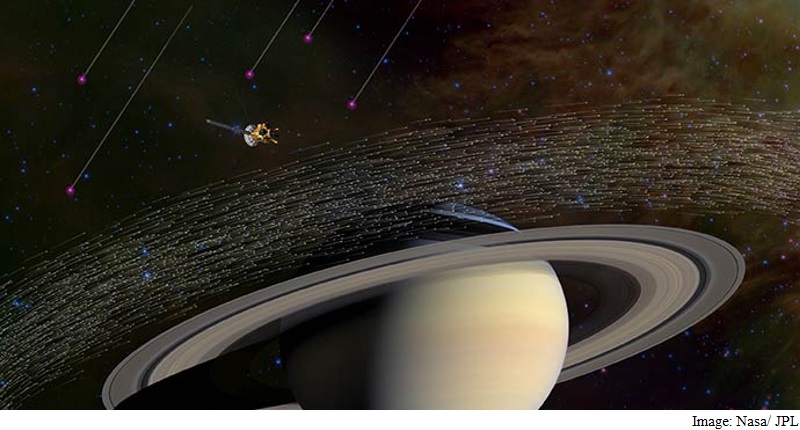- Home
- Science
- Science News
- Nasa's Cassini Probe Detects Interstellar Dust for First Time
Nasa's Cassini Probe Detects Interstellar Dust for First Time

The tiny dust grains were speeding through the Saturn system at over 72,000km per hour.
Cassini analysed the composition of the dust for the first time, showing it to be made of a very specific mixture of minerals not ice.
"We're thrilled Cassini could make this detection, given that our instrument was designed primarily to measure dust from within the Saturn system, as well as all the other demands on the spacecraft," noted Marcia Burton, Cassini fields and particles scientist at Nasa.
Cassini has been in orbit around Saturn since 2004, studying the giant planet, its rings and its moons.
The spacecraft has also sampled millions of ice-rich dust grains with its cosmic dust analyser instrument.
Among the myriad microscopic grains collected by Cassini, a special few, just 36 grains, stand out from the crowd.
Scientists conclude these specks of material came from interstellar space, i.e. the space between the stars.
"From that discovery, we always hoped we would be able to detect these interstellar interlopers at Saturn with Cassini. We knew that if we looked in the right direction, we should find them," said Nicolas Altobelli, Cassini project scientist at European Space Agency (ESA).
The grains all had a surprisingly similar chemical make-up, containing major rock-forming elements like magnesium, silicon, iron and calcium in average cosmic proportions.
"Indeed, on average, we have captured a few of these dust grains per year, travelling at high speed and on a specific path quite different from that of the usual icy grains we collect around Saturn," he explained.
Stardust grains are found in some types of meteorites which have preserved them since the birth of our solar system.
They are generally old, pristine and diverse in their composition.
"The long duration of the Cassini mission has enabled us to use it like a micrometeorite observatory, providing us privileged access to the contribution of dust from outside our solar system that could not have been obtained in any other way," said Altobelli in a paper published in the journal Science.
Alien dust in the solar system is not unanticipated.
In the 1990s, the ESA/Nasa Ulysses mission made the first observations of this material which were later confirmed by Nasa's Galileo spacecraft.
The dust was traced back to the local interstellar cloud: a nearly empty bubble of gas and dust that our solar system is traveling through with a distinct direction and speed.
For the latest tech news and reviews, follow Gadgets 360 on X, Facebook, WhatsApp, Threads and Google News. For the latest videos on gadgets and tech, subscribe to our YouTube channel. If you want to know everything about top influencers, follow our in-house Who'sThat360 on Instagram and YouTube.
Related Stories
- Galaxy S24 Series
- MWC 2024
- Apple Vision Pro
- Oneplus 12
- iPhone 14
- Apple iPhone 15
- OnePlus Nord CE 3 Lite 5G
- iPhone 13
- Xiaomi 14 Pro
- Oppo Find N3
- Tecno Spark Go (2023)
- Realme V30
- Best Phones Under 25000
- Samsung Galaxy S24 Series
- Cryptocurrency
- iQoo 12
- Samsung Galaxy S24 Ultra
- Giottus
- Samsung Galaxy Z Flip 5
- Apple 'Scary Fast'
- Housefull 5
- GoPro Hero 12 Black Review
- Invincible Season 2
- JioGlass
- HD Ready TV
- Laptop Under 50000
- Smartwatch Under 10000
- Latest Mobile Phones
- Compare Phones
- Huawei Pura 70 Pro+
- Huawei Pura 70 Ultra
- Tecno Camon 30 Premier 5G
- Motorola Edge 50 Fusion
- Oppo A1i
- Oppo A1s
- Motorola Edge 50 Ultra
- Leica Leitz Phone 3
- Asus ZenBook Duo 2024 (UX8406)
- Dell Inspiron 14 Plus
- Realme Pad 2 Wi-Fi
- Redmi Pad Pro
- Cult Shock X
- Fire-Boltt Oracle
- Samsung Samsung Neo QLED 8K Smart TV QN800D
- Samsung Neo QLED 4K Smart TV (QN90D)
- Sony PlayStation 5 Slim Digital Edition
- Sony PlayStation 5 Slim
- IFB 2 Ton 3 Star Inverter Split AC (CI2432C323G1)
- Daikin 1 Ton 3 Star Inverter Split AC (FTKL35UV16W+RKL35UV16W)

















